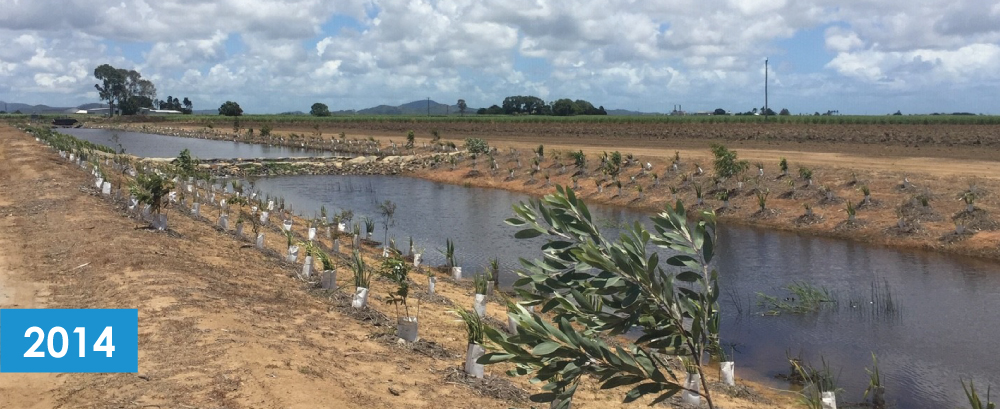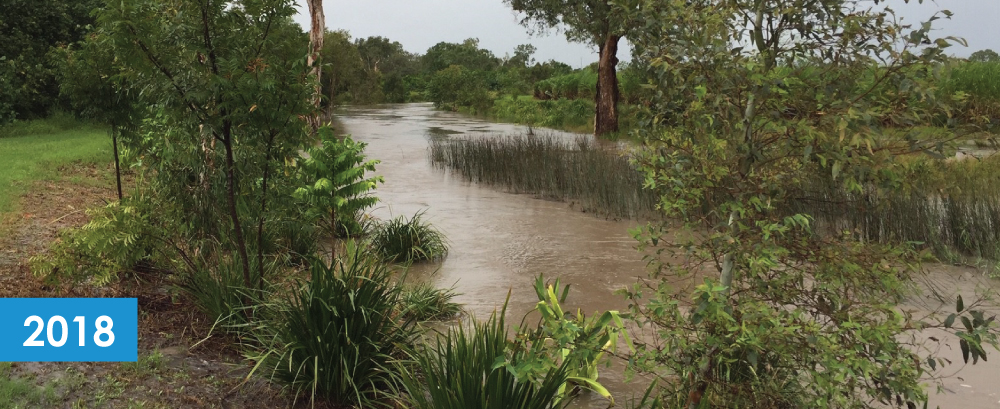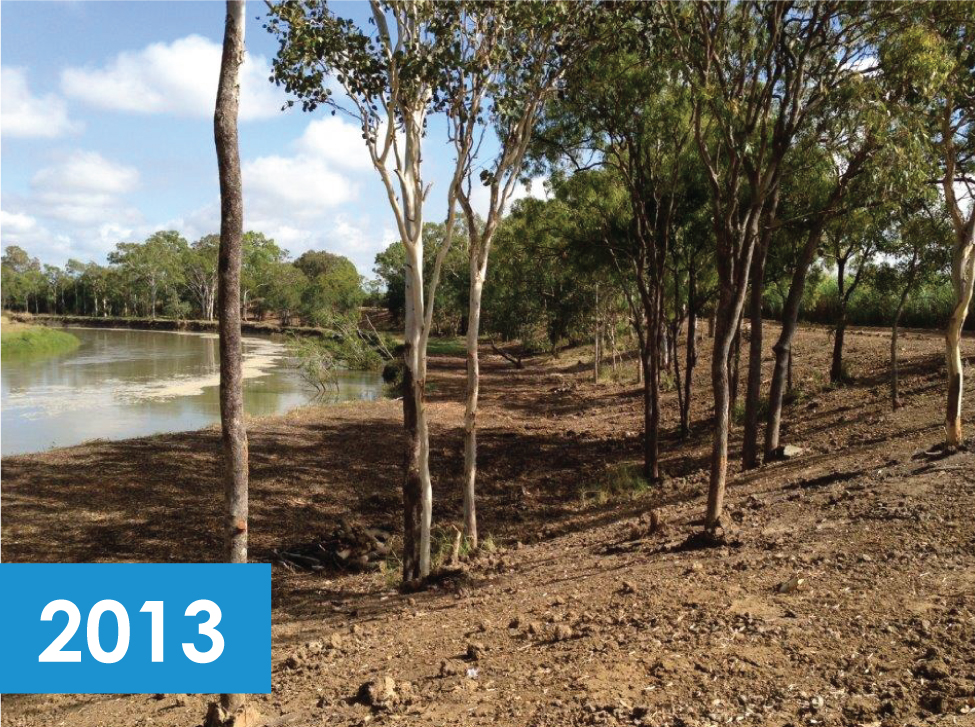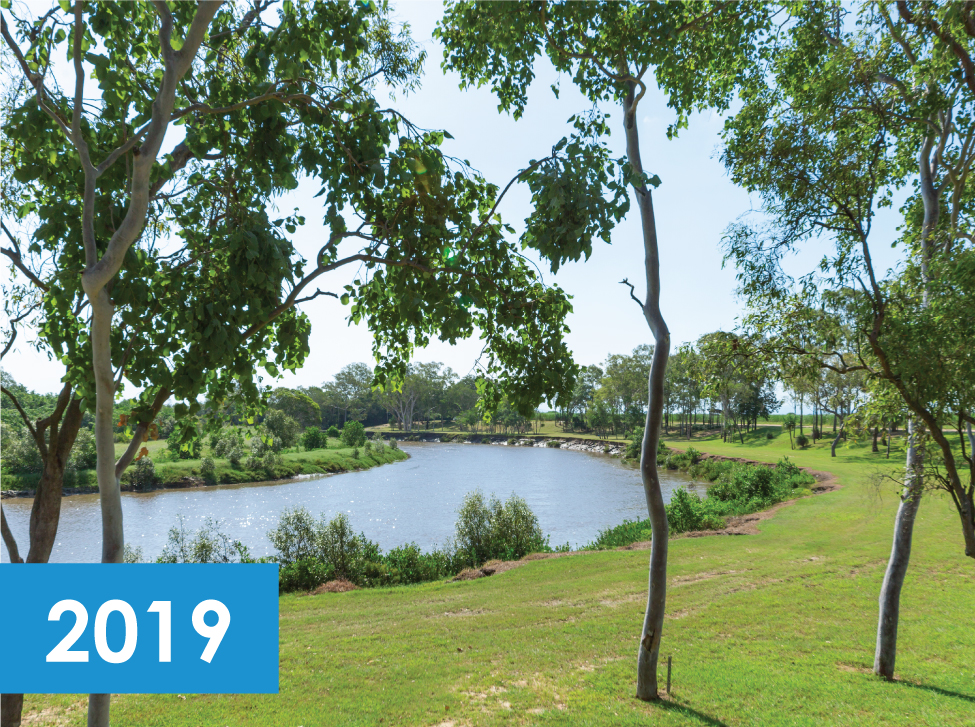Explore The Waters Ooralea community and you’ll notice the attention given to our natural surroundings, the lush landscaping, an abundance of native tropical plants and well-maintened lawns. You will also discover vast parklands complete with a Melaleuca Forest, 1.5km of creek bank, a dam along with a treatment train of wetlands to help improve water quality and biodiversity.
Here at The Waters Ooralea, we care about the environment and work to minimise our environmental footprint and help improve and protect the ecosytems, biodiversity and catchment areas within and surrounding the land estate.
Click below to find out more:
Wetland Treatment Train
Wetland ‘treatment train’ improves water quality and runoff from agricultural land
The Bakers Creek Treatment Train Wetland Project was undertaken as part of the Reef Rescue initiative package from the government to improve water quality to coastal water systems to help protect the Great Barrier Reef.
Catchment Solutions, in collaboration with Reef Catchments NRM and The Waters Ooralea have created a treatment train of wetlands to treat poor water quality runoff from adjacent sugar cane farms reaching the Great Barrier Reef (GBR) in the Bakers Creek Catchment, Mackay in central QLD.
The treatment train approach to improving water quality enables water to pass through multiple chambers to reduce nutrient, sediment and pesticides before exiting to the waterways.
The project took an holistic approach to wetland design, by treating water quality flowing to the GBR while also providing and enhancing habitat for biodiversity.
This was achieved by constructing four water quality treatment chambers – sediment basin, deep water macrophyte zone, detention irrigation re-use chamber and rehabilitating the existing wetland (last chamber). Endemic native vegetation was planted around the wetland, including macrophytes in the deep marsh zone. A rock-ramp fish ladder was also constructed to improve aquatic connectivity between the downstream estuary and the constructed wetland, which provides important habitat for economically important fish species such as barramundi.
The wetland was designed to capture and treat the first flush flow event (30-40 mm) of the wet season (Oct-Dec), prior to discharging into an existing wetland before eventually flowing into Bakers Creek Estuary and the GBR.
The landholder (cane farmer) is able to re-use the water from the third chamber to irrigate his sugar cane crop. Prior to the construction of the upstream treatment chambers, water high in nutrients,herbicides and pesticides flowed straight into the wetland causing fish kills.This water was then pumped right down for irrigation re-use onto adjacent sugar cane. Now, this wetland is managed for biodiversity, with the water treated in upstream chambers and no pumping down of the biodiversity wetland.
Water quality sampling was undertaken during flow events via auto samplers. The results have been significant, delivering both environmental improvement, as well as allowing the cane farmer access to increased irrigation capacity. Fish ladder monitoring and fish community electrofishing have also occurred.
Information source:
https://catchmentsolutions.com.au/this-train-is-a-treat/
Water quality monitoring was undertaken over two years using fixed auto-samplers located at the inlet and outlet of the wetland. Electrofishing and fishway trap monitoring were undertaken to monitor fish communities. The results have been outstanding with significant reductions in nutrients and herbicides at the outlet compared to the inlet and native fish community abundance increasing by 3406%
Results (snap shot)
Event 1 (30-40 mm) Dec 2014
NOx-N – 85% reduction
Phosphorus (total and ortho-P) – 50% reduction
Diuron – 59% reduction
Atrazine – 61% reduction
Hexazinone – 55 % reduction
Between last flow event in Feb 2015 to October 2015
86% reduction of N
90% for P
80% for TSS
Fish Sampling Results
There is a 3406% increase in native fish abundance in the wetland after the construction of the fishladder when compared to before. So, native fish were captured at 4.8 fish per minute of sampling before construction, while after fishladder construction (the average of 3 sampling occasions post construction) there was on average 163.7 fish per minute.
The number of Native Fish species have more than doubled.
N
Pre fishladder = 3 native fish
Post fishladder = 7 native fish
= 133% increase
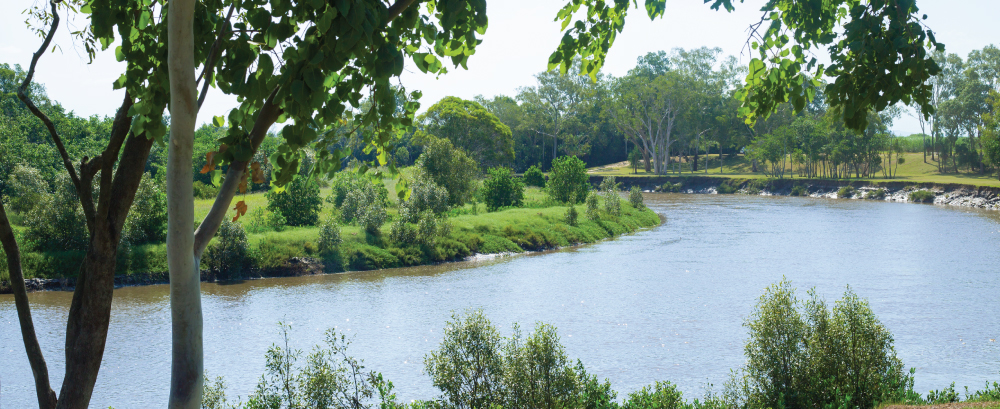
Ecosystems and Biodiversity
Here at The Waters Ooralea we ensure we assist in monitoring, measuring and conserving our ecosystems and biodiversity within the estate.
The creekbank, wetlands and parkland areas are regularly maintained by an in-house maintenance team. Monitoring and upgrades to the Wetlands Treatment Train are performed by Catchment Solutions and Reef Catchments
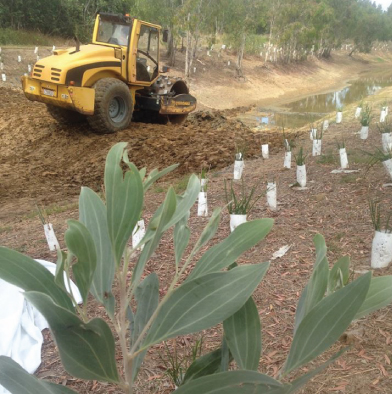
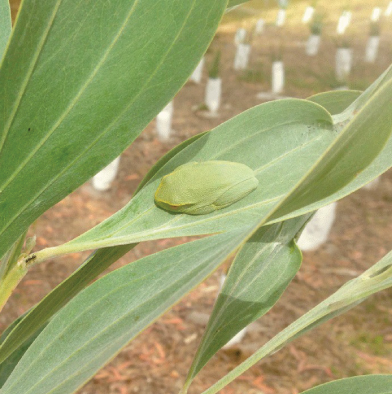
Habitat Rehabilitation
Over the past 6 years, The Waters Ooralea team have worked collaboratively with Catchment Solutions by planting over 10,000 trees and plants to prevent erosion of gullies and riverbanks. This helps assist with soil stability to limit soil run-off and limit fine sediment entering into the reef catchment area and help in reduce the carbon dioxide into our earth’s atmosphere. It’s also a valuable new native vegetation habitat for wildlife, helping improve the area’s biodiversity.
Wildlife at The Waters Ooralea
You can discover a variety of wildlife when you explore The Waters Ooralea including a variety of birdlife including; Pelicans, Ducks, the Australian Darter, Pheasants, Kingfishers and more.
Thanks to the Wetland Treatment Train and fish ladder, native fish community abundance has increased by 3406%. The number of Native Fish species have more than doubled.
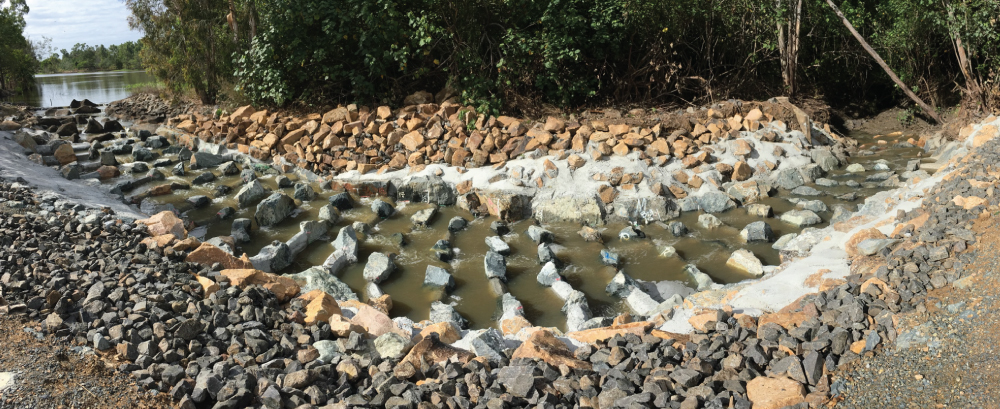
Rock-ramp Fishway ‘Fish Ladder’
An often overlooked but important design feature of constructed wetlands is connectivity with downstream aquatic habitats. Connectivity issues are confounded by the construction of wetland riser outlets, which block fish passage. Wetlands provide critical nursery habitats for many fish species, including economically important fish species such as barramundi. To further increase biodiversity values of the wetland system, a 23 ridge nature-like rock-ramp fishway was constructed in 2014 to provide connectivity with downstream aquatic habitats. In June 2018, this fishway was upgraded by Catchment Solutions to a 38 ridge nature-like rock-ramp fishway.
Mackay Whitsunday has approximately 50 freshwater fish species, in-which just over 50% breed in marine environments such as estuaries before the juveniles undertake an upstream migration into freshwater creeks and wetlands. Important recreational, commercial and indigenous fishery species such as; barramundi, mangrove jack, jungle perch, tarpon, giant herring and sea mullet all undertake this migration between saltwater and freshwater to complete their life-cycle. Fish generally migrate upstream into freshwater habitats as juveniles, where the abundance of in-stream habitat such as aquatic plants and logs provide both safe refuge for juvenile fish to evade predators and lots of prey species (food) for them to eat, enabling them to grow rapidly before they migrate back to the estuary as sub-adults, where they enter the fishery and are caught by recreational fisherman i.e. barramundi. Barriers to fish passage such a weirs, pipes, causeways and dams block this critical migration and reduce fish populations. Fishladders enable this important migration past fish barriers by providing a series of pools interspersed with small drops (100 mm) – acting like a set of underwater stairs. Native fish particularly small-bodied and juvenile species don’t have the energy reserves to swim fast for a long time without having a break to recover. The fishladder is designed so that fish can use their ‘burst speed’ which enables them to swim fast for a short duration (200 mm) through the gaps (100 mm drops) between the ridges, before resting in the pools and eventually ascending successfully to the top.
It’s a nature-like rock ramp fishladder constructed on a 3.8 m high fish barrier (height between the estuary downstream and upstream wetland). The configuration consists of 38 ‘pools’ and ‘rock ridges’ with 100 mm drops between pools. Rock ridges both separate and form the 100 mm drop between pools. Ridges are constructed using a excavator to place large rock boulders weighing between 1-5 tonne into specific positions determined by a laser level. The ridges form the pools, which are 0.6 m deep, 0.9 m long and 5 m wide. Due to site constraints (lack of available space) a new and innovative design was required for this site, which included large resting areas in each pool along the entire length of one side of the fishladder. This was achieved by blocking out the two most outside slots with concrete, and therefore reducing the stream flow to pool immediately downstream from the ‘block outs’, creating still water resting areas low in turbulence and velocity. These resting areas provide ideal conditions for fish to rest and regain their energy before swimming upstream through the next ridge.
This design feature was required because the lack of available space meant that the rock ridges and associated pools could only be spaced at 900 mm intervals so that the fishladder could fit within the site (which is very close – usually rock ridges are spaced at 2.5 m intervals). The close proximity of ridges results in increased turbulence in the pools, which tires out the migrating fish, reducing their chances of successfully making it the the top of the fishladder. However, the large resting areas on one side of each pool creates a resting area with low turbulence and velocity, which in-turn enables fish to rest, regain their energy and ascend to the wetland upstream.
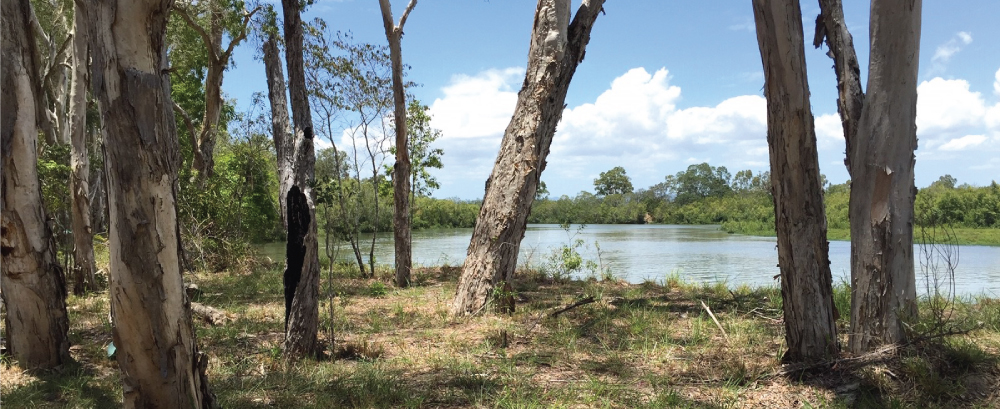
Melaleuca Forest
Hidden away inside of The Waters Ooralea is a breathtaking Melaleuca Forest, residents can access and take advantage of this secret spot by the water. Also known as paper bark trees, the Melaleuca forest is home to a diverse range of wildlife and plant habitats.
Walking tracks and fishing platforms will be developed in the future throughout the area so residents can enjoy the serenity of our Melaleuca Forest by the water.
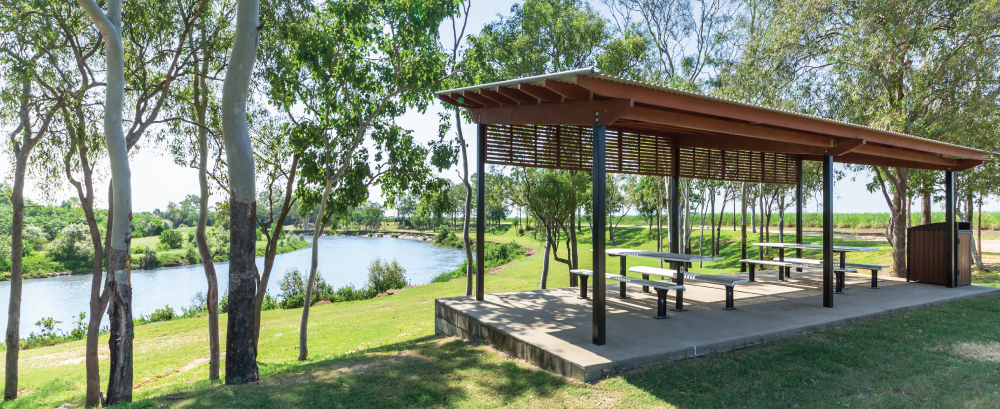
Community Parklands
Here are The Waters Ooralea we aim to bring the community together through a thoughtful Masterplanned design to create a safe, vibrant and healthy community.
Our goal is to build a strong sense of community and encourage a healthy active outdoor lifestyle. Residents enjoy being able to spend more quality time with family taking advantage of the parkland features in the estate, right at their doorstep;
- 1.5km of Water Frontage
- Melaleuca Forest
- Walkways
- Picnic Shelters and seating by the creek
- Park & playground
- Outdoor Gym Equipment
The future is very exciting at The Waters Ooralea!
The Masterplan includes four more parks and playgrounds to be constructed, walkways around the creekbank and within the Melaleuca Forest and recreational amenities by the creekbank including; outdoor gym equipment, sporting facilities, BBQs, additional picnic shelters and fishing platforms.
The Waters Ooralea is the only estate in Mackay to offer all this in one place. Sign up to our Mailing List for updates about the estate’s progress.
